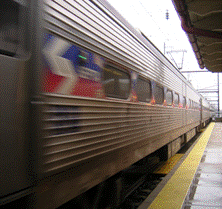 One of the great (and least often appreciated) things about a long established city is its well developed public transportation network. Philadelphia and its suburbs are no exception.
One of the great (and least often appreciated) things about a long established city is its well developed public transportation network. Philadelphia and its suburbs are no exception.
Before the widespread use of the automobile, one of the key advantages that came with city living was its easy access to public transportation both within and around the surrounding area. Philadelphia has always been at the forefront of transportation development. Originally dependent primarily on river transportation, it quickly benefited from early road, rail, and canal development due to its prime East Coast location. This was hastened by the state when Pennsylvania created the Main Line of Public Works which opened in 1834.
Beginning in the 1840s, Philadelphia continued to build on its strong East Coast position, as the Pennsylvania Railroad, headquartered in Philadelphia, developed one of the finest rail systems in the world. This provided easy access for Philadelphians and their businesses to connections throughout the country. The railroad was a major economic force until its eventual demise in the 1970's. 
Today, rail remains a critical transportation component both locally and regionally. In Delaware County, the original Main Line still runs across its northern border through Radnor township. Running along its southern border, the all important Northeast Corridor continues to connect the major northeast coastal cities from Boston, through New York, Philadelphia, Wilmington, Baltimore, and down to Washington, DC.
Concurrently with the development and growth of intercity rail, demand grew for local transportation options as well. These were answered by the development of local train, trolley, and other light rail options. The first horse drawn public transportation appeared in 1831, the first passenger train service arrived in 1832, the first electric trolley line arrived in 1892, and the first bus lines followed in 1923. Over time, these merged, went out of business, or were replaced by other forms of transportation until the final consolidation by the government with the advent of SEPTA.
 SEPTA was founded in 1964, and by 1983 it had responsibility for all the public transportation systems within the Philadelphia region. Today it is the 5th largest public transportation system in the country. According to SEPTA's web site, the system includes, rail, light rail, bus, and trolley systems spanning 316 stations/bus terminals, 2664 vehicles, almost 9000 employees, and has a 325 million annual ridership. The system covers Delaware County with 2613 Septa stops including 54 rail stops on 3 regional rail lines and multiple trolley/high speed rail lines. These rail connections are concentrated in the eastern, northern, and southern areas of the county while the central and western sections are primarily accessed through bus service.
SEPTA was founded in 1964, and by 1983 it had responsibility for all the public transportation systems within the Philadelphia region. Today it is the 5th largest public transportation system in the country. According to SEPTA's web site, the system includes, rail, light rail, bus, and trolley systems spanning 316 stations/bus terminals, 2664 vehicles, almost 9000 employees, and has a 325 million annual ridership. The system covers Delaware County with 2613 Septa stops including 54 rail stops on 3 regional rail lines and multiple trolley/high speed rail lines. These rail connections are concentrated in the eastern, northern, and southern areas of the county while the central and western sections are primarily accessed through bus service.
Today this network provides easy commuting options both within the county and to downtown Philadelphia and continues to be a major benefit and draw for people living, working, and enjoying all that the area has to offer. In the future, I will be highlighting major stops of these rail lines to provide a better feel for the individual communities and their development.

Comments(1)